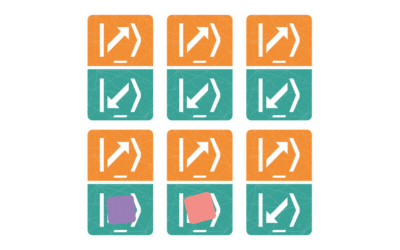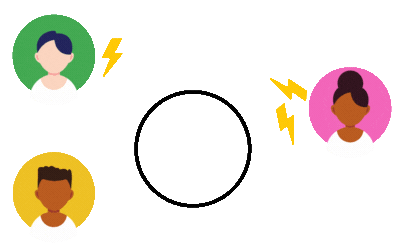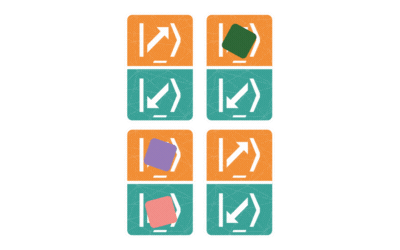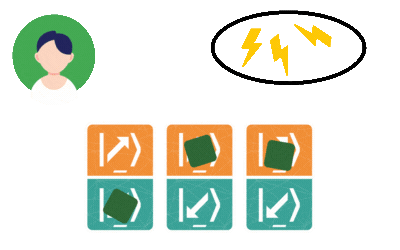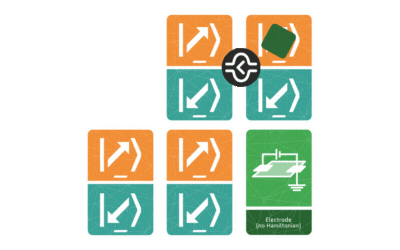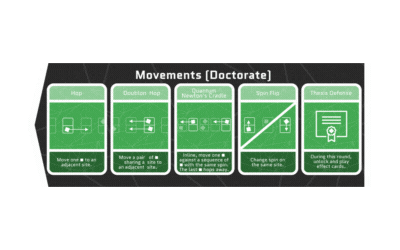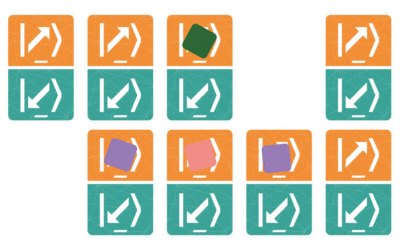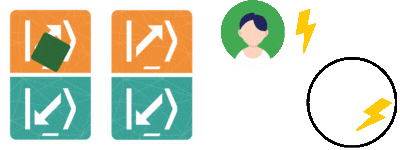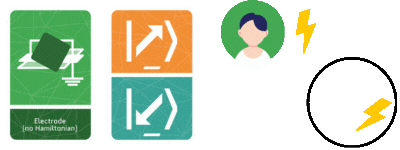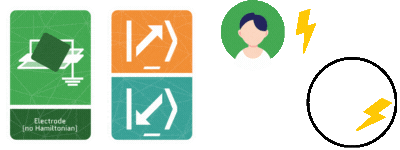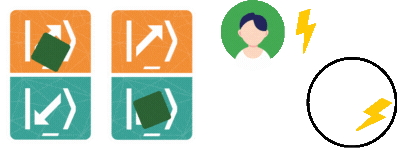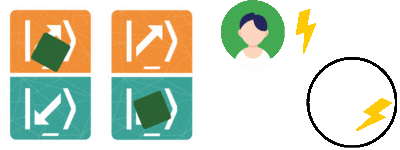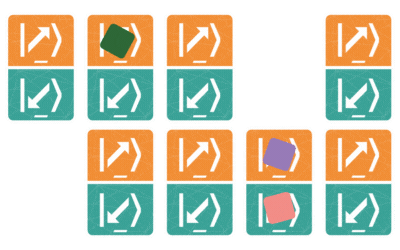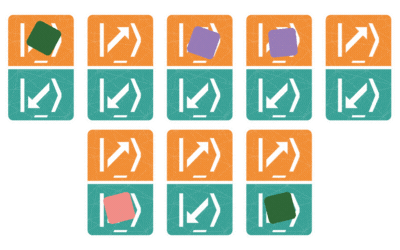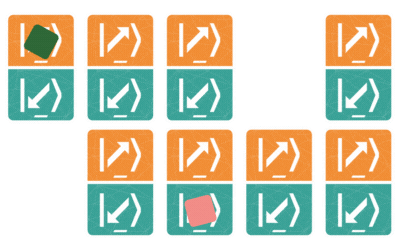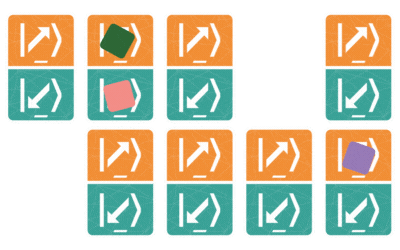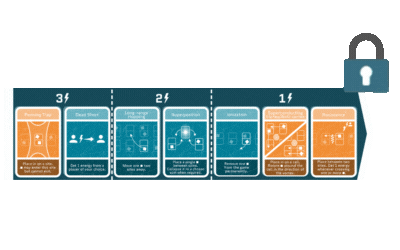Rules
2 to 4 players · 15 minutes · +14 · Strategy · Expert
Introduction
«Quantum»? Did you say «quantum»? With |Hop>, come and explore the world of atoms. Move your electrons, use physical properties and discover the exciting world of physics!
You are physicists at the university. An accident has occurred: a state-of-the-art experimental machine short-circuited. Each person is trying to prove that it was the others who made the mistake.
Grants are at stake! So, roll up your sleeves and heat up the electrodes!

Game principle
Players take turns moving electrons from their electrode card and through the site cards that make up the board. The game ends when a player places at least one electron onto an opponent’s electrode.
The player whose electrode gets reached is short-circuited and loses. The others are safe… for this round!
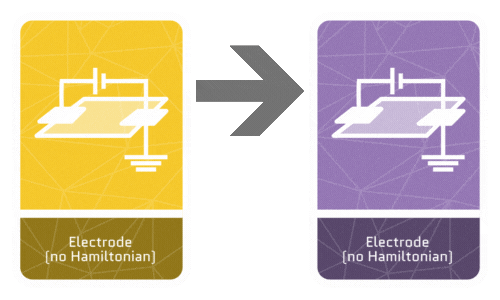
Components
3 foldable boards

1 Effects board
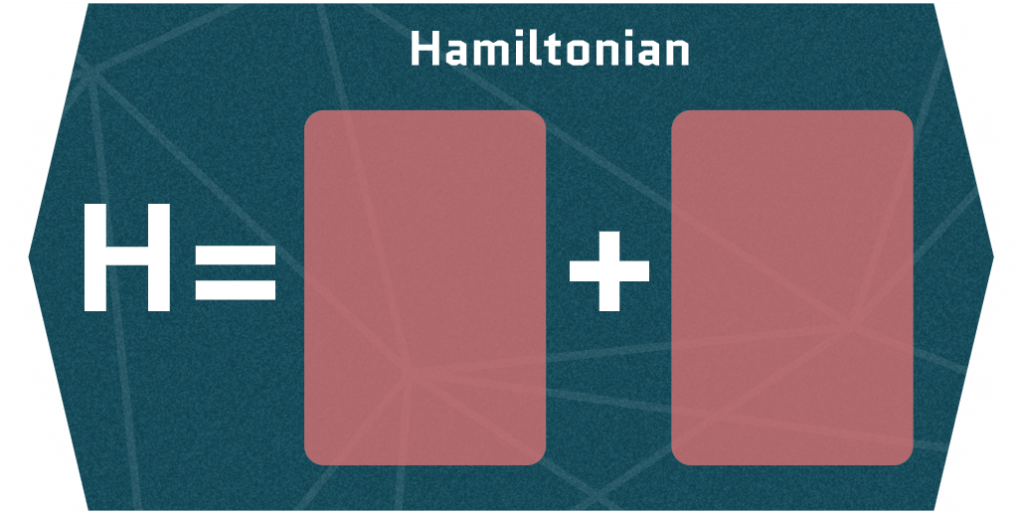
1 Hamiltonian board
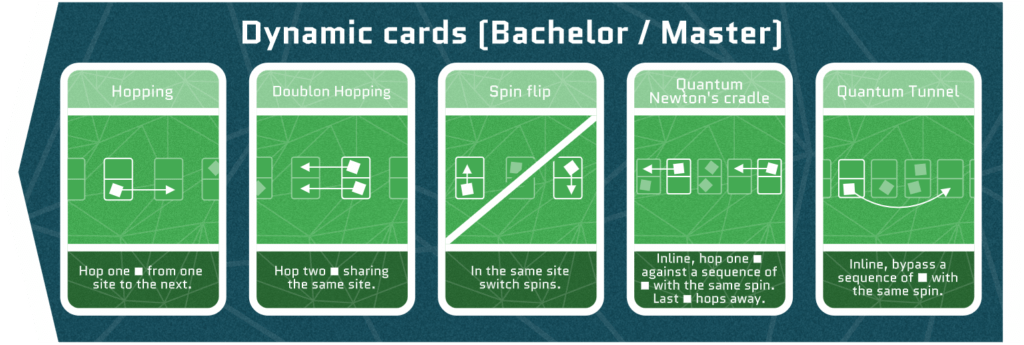
1 Movement board
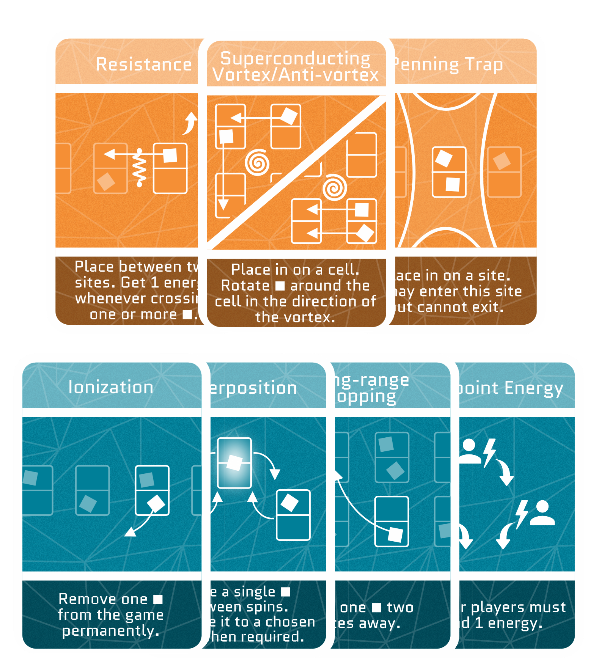
7 Effects Cards

36 Site Cards
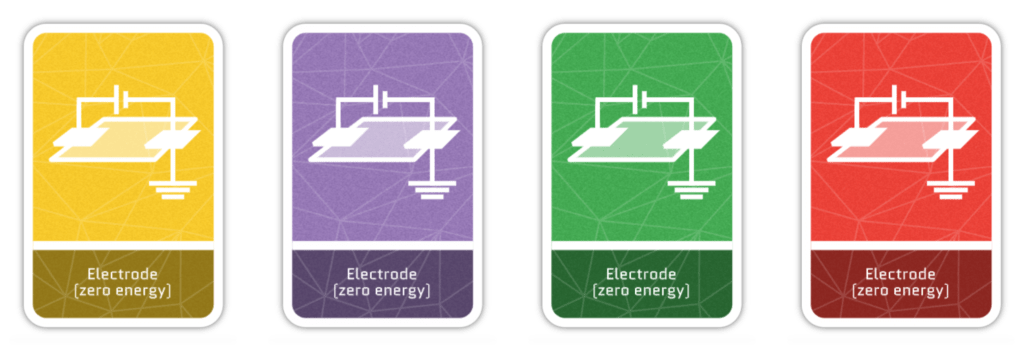
4 Electrode cards
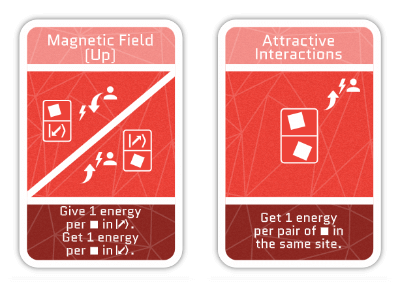
2 Hamiltonian Cards

4 player tokens
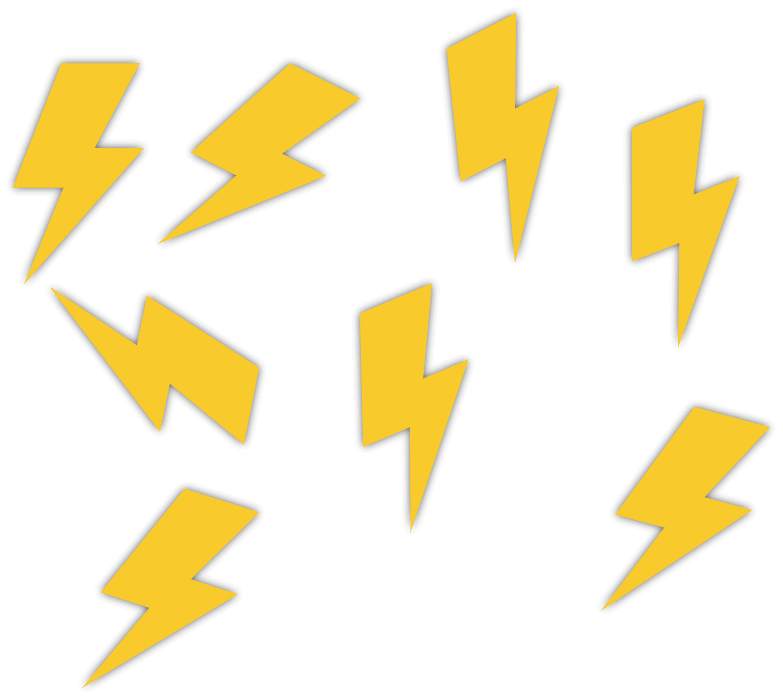
8 Energy tokens
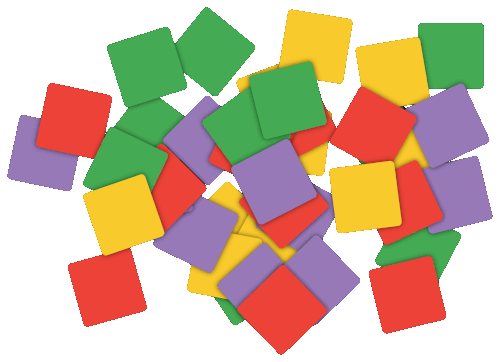
28 electron tokens (7 per electrode's color)

15 effect tokens (3 per type)
Levels
|Hop> has three levels that build on each other. Play one game of Bachelor
(~5 min) and Master (~8 min) before attempting the most strategic level of Doctorate (~15 min).
Pick your level!
Expert

Beginner
Game setup
Pick a color and create the board by laying out the site and electrode cards in a square grid as below.
With 4 players, partner with the person sitting across from you to reach any terminal of the opposing team so, make sure to be seated accordingly. Your electrons can freely explore your partner’s terminal.

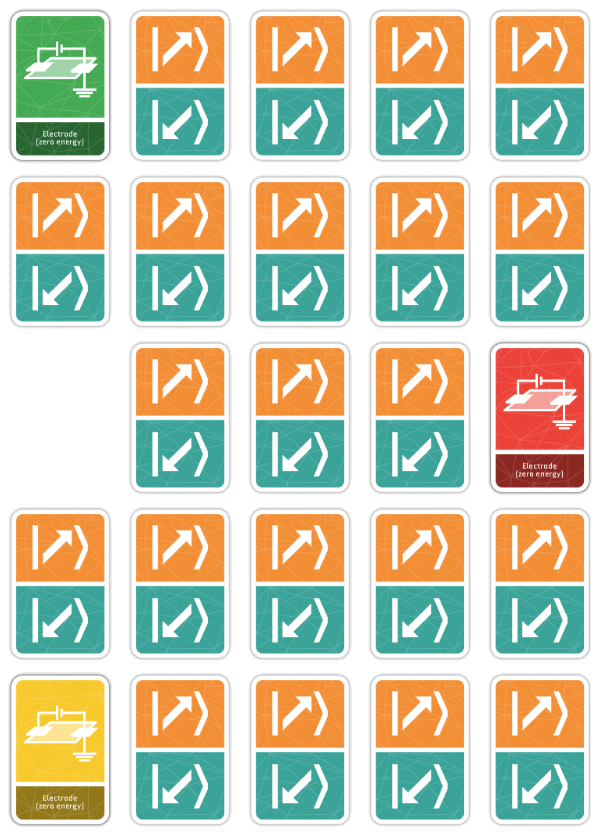

Then, place the Mouvement board on the Bachelor/Master, and the player’s tokens next to it. Place the 7 electron tokens of the same color onto the respective electrode card. Store away the rest.

Then, place the Mouvement board on the Bachelor/Master, and the player’s tokens next to it. Place the 7 electron tokens of the same color onto the respective electrode card.
Place the Hamiltonian board with the magnetic field and attractive interaction cards on top. Place 8 Energy tokens next to it and accessible to all. With 2 players, each gets 2 Energies to start. With 3 or 4 players, each gets 1 Energy. Keep them visible at all times and store away the rest.

Then, place the Mouvement board on the Doctorate, and the player’s tokens next to it. Place the 7 electron tokens of the same color onto the respective electrode card.
Place the Hamiltonian board with the magnetic field and attractive interaction cards on top. Place 8 Energy tokens next to it and accessible to all. With 2 players, each gets 2 Energies to start. With 3 or 4 players, each gets 1 Energy. Keep them visible at all times.
Flip the movement board to the doctorate side. Place the Effects board and position all the effect cards randomly (side as well) on top. Position the Effect tokens next to it.

General Rules

SPIN LEVELS
The site cards are divided into two levels: spin up (orange part) and spin down (blue part).
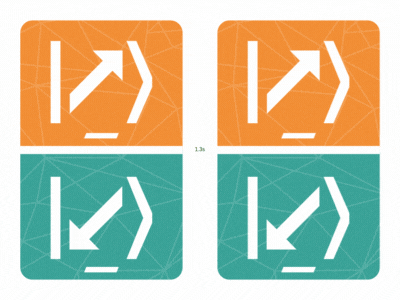
ORIENTATION
The orientation of the sites does not matter. Imagine the spin up as a level above the terminal and the spin down as a level below it.
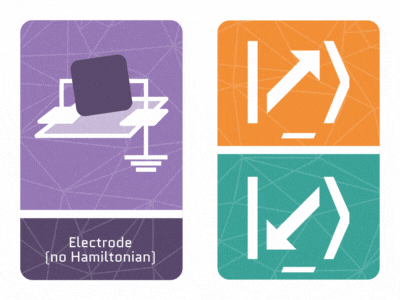
EXITING AN ELECTRODE
Electrodes do not have a defined spin. When moving an electron away from a electrode, you can choose its spin.

Unique Spins
There can never be more than a single electron (of any color) on the same site with the same spin.
Game round
Warning
Make sure the Movement board is on the Bachelor/Master side!
You only need to place at least one electron in an opponent’s electrode to win the game.
Warning
Make sure the Movement is on the Bachelor/Master side!
Make sure the Interactions card is on the Attractive Interaction side.
You only need to place at least one electron in an opponent’s electrode to win the game.
Warning
Make sure the Movement is on the Doctorate side!
Make sure the Interactions card is on the Attractive Interaction side.
You only need to place at least one electron in an opponent’s electrode to win the game.
- Each player takes turns counter-clockwise.
- Before your turn, the opponent to the left blocks a movement from the board by placing your player token on top of it.
- This movement cannot be used on this turn.
- The same movement cannot be blocked twice in a row.
- In your turn, play a maximum of two movements from the Movement board (see Movements section).
- All movements occur in a straight line along the grid directions (vertical or horizontal).
- Except for the spin flip, movements cannot change the spin.
- Every movement must be initiated by a player’s electron but may affect others’ electrons; i.e., the colors only matter for the starting electron.
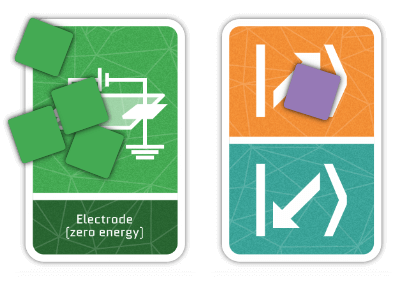
Note for experienced players
If you are used to strategy games, skip to the next level : this version’s goal is to learn Movement mechanisms.
- Each player takes turns counter-clockwise.
- Before your turn, the opponent to the left blocks a movement from the board by placing your player token on top of it.
- This movement cannot be used on this turn.
- The same movement cannot be blocked twice in a row.
- In your turn, play a maximum of two movements from the Movement board (see Movements section).
- All movements occur in a straight line along the grid directions (vertical or horizontal).
- Except for the spin flip, movements cannot change the spin.
- Every movement must be initiated by a player’s electron but may affect others’ electrons; i.e., the colors only matter for the starting electron.
- With each movement, the player must balance the energy according to the Hamiltonian cards (see Hamiltonian section).
- The player initiating the movement exchanges the energy, regardless of which electrons are affected.
- If you do not have enough energy (in hand or in the pool), you cannot make the move.
- The color of the electrons does not matter when computing the energy.

Note for experienced players
If you are used to strategy games, skip to the next level : this version’s goal is to learn Energy mechanisms on top of Movement mechanisms.
You can spice up the game by changing the number and layout (square, triangle, hexagon, etc.) of the cards forming the board.
- Each player takes turns counter-clockwise.
- Before your turn, the opponent to the left blocks a movement from the board by placing your player token on top of it.
- This movement cannot be used on this turn.
- The same movement cannot be blocked twice in a row.
- In your turn, play a maximum of two movements from the Movement board (see Movements section).
- All movements occur in a straight line along the grid directions (vertical or horizontal).
- Except for the spin flip, movements cannot change the spin.
- Every movement must be initiated by a player’s electron but may affect others’ electrons; i.e., the colors only matter for the starting electron.
- With each movement, the player must balance the energy according to the Hamiltonian cards (see Hamiltonian section).
- The player initiating the movement exchanges the energy, regardless of which electrons are affected.
- If you do not have enough energy (in hand or in the pool), you cannot make the move.
- The color of the electrons does not matter when computing the energy.
- Playing the thesis defense unlocks the Effects board to be used at any time during the turn (see Effect section).
- The cost of an effect is indicated on top of the board and paid to the pool.
- Effects are not subjected to energy conservation.
- You can use as many effects as you can afford during your turn. They must be used immediately and only once.
- Orange effects place permanent tokens on the board that can only be removed by re-using the same effect or destroying a site in contact with them.
- Two tokens cannot influence the same site, and they can never influence an electrode.
- After the turn, used effects are moved to the most costly positions on the effects board. The remaining effects are shifted right.

Effects
Reminder: Effects can be used to enter/exit an electrode. No energy exchange required besides their cost.
Energy and Hamiltonian
When a movement increases the grid’s energy, the player must give to the pool the corresponding number of energy tokens (↓-). Vice-versa, they get tokens when the energy decreases (↑+).
The number of energies exchanged is calculated by adding the contributions of both Hamiltonian cards.

Magnetic Field
In a magnetic field, different spins contribute differently to the energy.
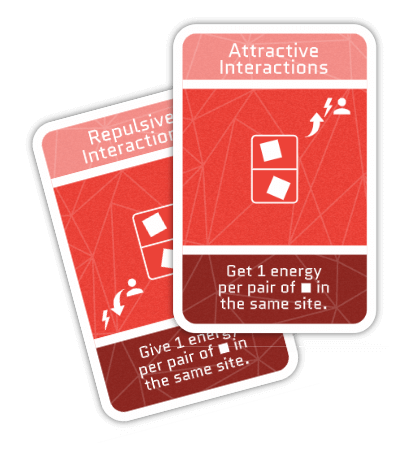
Interactions
When two electrons share the same site, there is an extra contribution to the energy.
Movements
Reminder: All movements can be used to enter/exit an electrode.

